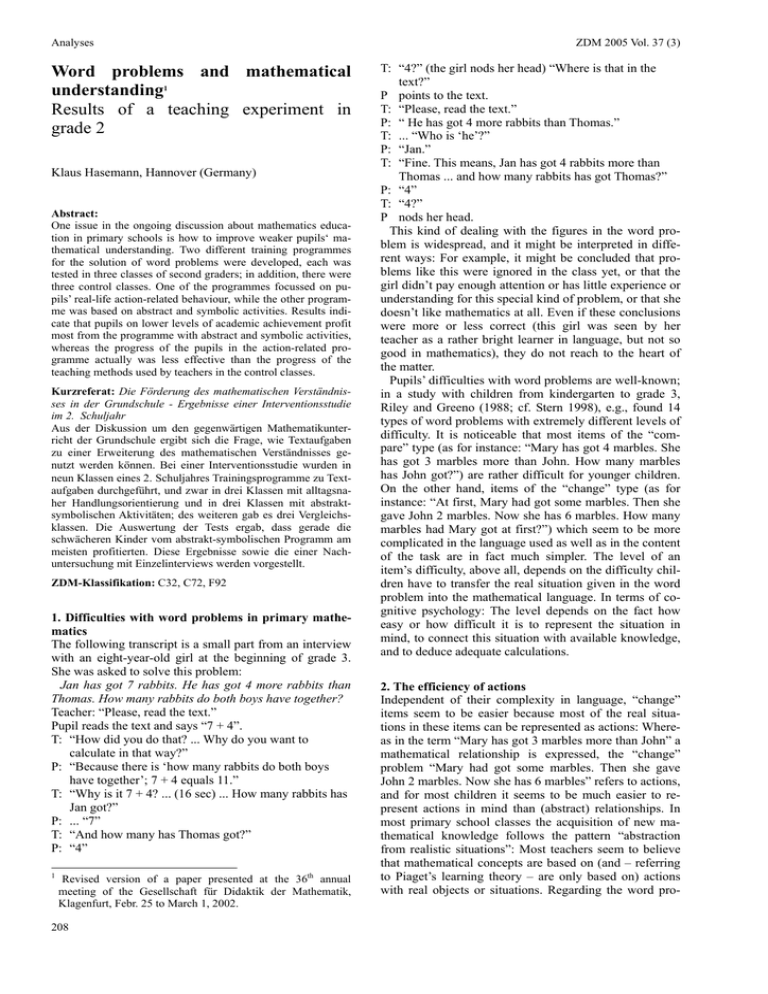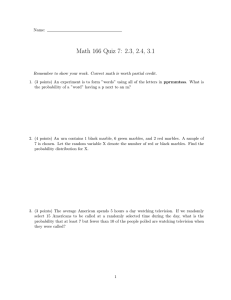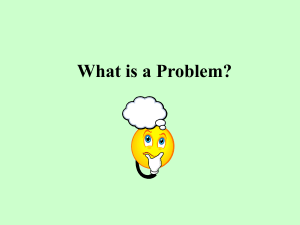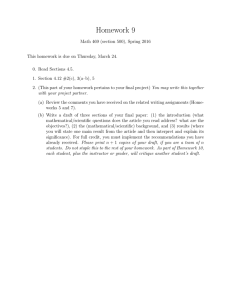Word problems and mathematical understanding Results of a teaching experiment in
advertisement

Analyses Word problems and mathematical understanding1 Results of a teaching experiment in grade 2 Klaus Hasemann, Hannover (Germany) Abstract: One issue in the ongoing discussion about mathematics education in primary schools is how to improve weaker pupils‘ mathematical understanding. Two different training programmes for the solution of word problems were developed, each was tested in three classes of second graders; in addition, there were three control classes. One of the programmes focussed on pupils’ real-life action-related behaviour, while the other programme was based on abstract and symbolic activities. Results indicate that pupils on lower levels of academic achievement profit most from the programme with abstract and symbolic activities, whereas the progress of the pupils in the action-related programme actually was less effective than the progress of the teaching methods used by teachers in the control classes. Kurzreferat: Die Förderung des mathematischen Verständnisses in der Grundschule - Ergebnisse einer Interventionsstudie im 2. Schuljahr Aus der Diskussion um den gegenwärtigen Mathematikunterricht der Grundschule ergibt sich die Frage, wie Textaufgaben zu einer Erweiterung des mathematischen Verständnisses genutzt werden können. Bei einer Interventionsstudie wurden in neun Klassen eines 2. Schuljahres Trainingsprogramme zu Textaufgaben durchgeführt, und zwar in drei Klassen mit alltagsnaher Handlungsorientierung und in drei Klassen mit abstraktsymbolischen Aktivitäten; des weiteren gab es drei Vergleichsklassen. Die Auswertung der Tests ergab, dass gerade die schwächeren Kinder vom abstrakt-symbolischen Programm am meisten profitierten. Diese Ergebnisse sowie die einer Nachuntersuchung mit Einzelinterviews werden vorgestellt. ZDM-Klassifikation: C32, C72, F92 1. Difficulties with word problems in primary mathematics The following transcript is a small part from an interview with an eight-year-old girl at the beginning of grade 3. She was asked to solve this problem: Jan has got 7 rabbits. He has got 4 more rabbits than Thomas. How many rabbits do both boys have together? Teacher: “Please, read the text.” Pupil reads the text and says “7 + 4”. T: “How did you do that? ... Why do you want to calculate in that way?” P: “Because there is ‘how many rabbits do both boys have together’; 7 + 4 equals 11.” T: “Why is it 7 + 4? ... (16 sec) ... How many rabbits has Jan got?” P: ... “7” T: “And how many has Thomas got?” P: “4” 1 Revised version of a paper presented at the 36th annual meeting of the Gesellschaft für Didaktik der Mathematik, Klagenfurt, Febr. 25 to March 1, 2002. 208 ZDM 2005 Vol. 37 (3) T: “4?” (the girl nods her head) “Where is that in the text?” P points to the text. T: “Please, read the text.” P: “ He has got 4 more rabbits than Thomas.” T: ... “Who is ‘he’?” P: “Jan.” T: “Fine. This means, Jan has got 4 rabbits more than Thomas ... and how many rabbits has got Thomas?” P: “4” T: “4?” P nods her head. This kind of dealing with the figures in the word problem is widespread, and it might be interpreted in different ways: For example, it might be concluded that problems like this were ignored in the class yet, or that the girl didn’t pay enough attention or has little experience or understanding for this special kind of problem, or that she doesn’t like mathematics at all. Even if these conclusions were more or less correct (this girl was seen by her teacher as a rather bright learner in language, but not so good in mathematics), they do not reach to the heart of the matter. Pupils’ difficulties with word problems are well-known; in a study with children from kindergarten to grade 3, Riley and Greeno (1988; cf. Stern 1998), e.g., found 14 types of word problems with extremely different levels of difficulty. It is noticeable that most items of the “compare” type (as for instance: “Mary has got 4 marbles. She has got 3 marbles more than John. How many marbles has John got?”) are rather difficult for younger children. On the other hand, items of the “change” type (as for instance: “At first, Mary had got some marbles. Then she gave John 2 marbles. Now she has 6 marbles. How many marbles had Mary got at first?”) which seem to be more complicated in the language used as well as in the content of the task are in fact much simpler. The level of an item’s difficulty, above all, depends on the difficulty children have to transfer the real situation given in the word problem into the mathematical language. In terms of cognitive psychology: The level depends on the fact how easy or how difficult it is to represent the situation in mind, to connect this situation with available knowledge, and to deduce adequate calculations. 2. The efficiency of actions Independent of their complexity in language, “change” items seem to be easier because most of the real situations in these items can be represented as actions: Whereas in the term “Mary has got 3 marbles more than John” a mathematical relationship is expressed, the “change” problem “Mary had got some marbles. Then she gave John 2 marbles. Now she has 6 marbles” refers to actions, and for most children it seems to be much easier to represent actions in mind than (abstract) relationships. In most primary school classes the acquisition of new mathematical knowledge follows the pattern “abstraction from realistic situations”: Most teachers seem to believe that mathematical concepts are based on (and – referring to Piaget’s learning theory – are only based on) actions with real objects or situations. Regarding the word pro- ZDM 2005 Vol. 37 (3) Analyses blems mentioned above, for most children therefore it is an easy task when they can deal with situations which include real objects or actions or which can easily be simulated with objects. This is true, e.g., for all problems of the “combine” type (as for instance “Mary has got 6 marbles. John has got 3 marbles. How many marbles do they have together?”), and also for a lot of “change” items, but not for the “compare” items. Following the pattern “abstraction from realistic situations” a sequence of symbols like “3 + = 7” makes sense for children when they have learnt to connect this sequence with different situations in such a way that they can transfer it also to new situations. One step on this mental process from situations to sequences of symbols (and back from symbols to situations) are diagrams which not just reproduce the situations but represent the relevant mathematical relations without irrelevant details. As an example we take the task There are 9 children on the red bus. There are 6 children more on the green bus than on the red bus. How many children are on the green bus? Fig. 1 is a picture of this situation with a lot of irrelevant details whereas the diagram in fig. 2 represents quantities and the relevant relationship between these quantities: Fig. 1: The red bus ||||||||| Fig. 2: The red bus The green bus ||||||||| |||||| The green bus A series of problems in a “bus context” has been developed by the “realistic mathematics education” project (realistisch rekenonderwijs) at the Utrecht University (cf., for example, Treffers, 1987, or Van den Brink, 1989). This context provides a lot of meaningful mathematical word problems related to addition and subtraction. Action-related thinking obviously becomes inadequate when the situation in a word problem cannot be simulated by actions. This is the case in word problems that can’t be described by cardinal numbers but are in need of relations between quantities. In fact, a problem becomes insoluble for a lot of children when a relation between quantities has to be recognised in the first step of the solving process which after that has to be used in a second step. The girl in the interview mentioned above had this problem: She referred to a cardinal number (“Thomas has got 4 rabbits”) and ignored the relation in the relevant statement (“He has got 4 rabbits more than Thomas”). Most lower achievers in mathematics are not able to detach their thinking from concrete objects and real actions; this weakness seems to be a reason why they are the less successful ones: “The properties by which the physical objects are described and classified need to be ignored; and attention is focused on the actions on the objects which have the potential to create an ’object of the mind’, which has new properties associated with new classifications and new relationships. For some there may be a cognitive shift from concrete to abstract in which the concept of number becomes conceived as a construct that can be manipulated in the mind. For others, however, meaning remains at an enactive level; elementary arithmetic remains a matter of performing or representing actions. ... It is our contention that different perceptions of these objects, whether mental or physical, are the heart of different cognitive styles that lead to success and failure in elementary arithmetic” (Gray, Pitta and Tall 1997, pp. 115, 117). These authors’ evidence is based on responses to a range of elementary context-free addition and subtraction problems given by children at ages from 7 to 11: “’Low achievers’ tended to highlight the descriptive qualities of the items in strongly personalised terms, ... there was a tendency to associate these items with a story in the sense that they were seen as pictures that required colour, detail and a realistic content. In contrast, ’high achievers’ concentrated on the more abstract qualities within (the) series of items. Though they initially focused on core concepts, they could traverse at will a hierarchicial network of knowledge from which they abstracted these notions or representational features” (p. 123). 3. An intervention study with pupils in grade 2 Hasemann and Stern (2002) carried out a 12 lessons intervention study in nine classes at the end of grade 2 in the Hannover area. At that time word problems were well-known to the children. Two different training programmes for the solution of word problems were developed, each of which was tested in three classes; in addition, there were three control classes. One of the programmes focussed on pupils’ real-life action-related behaviour. In this programme the teachers’ instructions followed the scheme “from the concrete to the abstract” (and were guided by the idea of “ongoing schematisation” developed in the Utrecht project mentioned above) while the other programme was based on abstract and symbolic activities (cf. 3.2). 3.1 Pupils‘ mathematical behaviour with items: some examples “Low achievers’” tendency to “highlight the descriptive qualities of the items in strongly personalised terms” was very clearly to be observed in our study. After having worked out the problem David collects Pokémon cards. Today he got 15 new cards. Now he owns 89 cards. How many cards did he own yesterday? in the 9th lesson of their programmes, the pupils were asked to make up their own story with the same mathematical structure as that in this problem. Most of the children were able to make up a story, but just 10 (of 43) of such stories had a similar mathematical structure as the problem mentioned (namely + b = c; cf., for example, fig. 3). Most of the stories which were created by the 209 Analyses ZDM 2005 Vol. 37 (3) children, however, looked like that one in fig. 4 which has a quite different (and very simple) mathematical structure (namely a + b = ) and, above all, shows the “descriptive qualities of the item in strongly personalised terms”. Fig. 5: 100 square Fig. 3: Tomas buys so and so many balls and then buys 5 more balls. How many had he got before? Now he has 20 balls. Calculation: 15 + 5 = 20 Answer: “At first he had got 15 balls.” Fig. 6: Number line The children also played “brain-games” like: “I think of two numbers. One is bigger by 5 than the other. Which numbers could it be?” Obviously the training-programme in these classes consisted mainly of exercises in which relations between numbers were emphasised. The competence that was developed thereby was used more and more by the pupils to solve the word problems. Ideas for exercises with the 100 square, the number line but also some other exercises as, for example “calculation walls” (see fig. 7), were taken from the “Handbuch produktiver Rechenübungen” (Wittmann and Müller 1993). 37 21 13 Fig. 4: Question: Natalie has got 2 dogs. She gets 10 dogs more. Calculation: 2 + 10 = 12 Answer: She has got 12 dogs altogether. The girl’s solution in fig. 3 is absolutely correct; this example is very pleasing as the girl is able to make up a mathematically correct solution (and even to use variables: “so und so fiel” / “so and so many”) although she obviously had some language problems. 3.2 An alternative teaching procedure to provoke insight in word problems In the research mentioned above, an “abstract-symbolic” training-programme was conducted in three classes. The mathematical relations and structures with particular difficulties for children were made explicit in these lessons, and specific help to overcome the obstacles were provided. This programme wasn’t “abstract” in the way that only formal calculations were talked about, but also action-related, with “games” appropriate for children at grade 2. The “games” were different from the ones in the “real-life” programme; in both programmes, however, they filled an equal amount of time. As media to visualise were used especially the 100 square and the number line (fig. 5 and 6). 210 8 Fig. 7: A calculation wall Exercises with the 100 square were similar to the following example: The children sat in a semicircle in front of a big 100 square-poster and followed a route on it given by the teacher: 1. At the beginning I stood on the 7. 2. Then I walked a step downwards. 3. After that I walked 26 steps forwards. 4. Then I walked 3 steps upwards and one to the left. 5. Where am I? In addition, the meaning of going a step to the right, left, upwards, downwards etc. spoken in arithmetical terms was made clear. The children found different ways of going 34 steps forwards, for example step by step or three lines downwards and four rows to the right, the particular calculations were written down. During the “Where am I”–game some pupils tried to follow the route blindfold. At the number line a game called “Mister X” was played: an empty number line (except the 0 and the 100) was drawn on the board and the teacher (or a pupil) wrote a number (called “Mister X”) between 0 and 100 on the back of the board. The players tried to guess this number by narrowing down the numeral range, it was only an- ZDM 2005 Vol. 37 (3) nounced whether the number was too small or too big; the players had 10 attempts at most. 4. Findings and conclusions Before and after the training-programme a test was carried out in the respectively three classes taking part in one of the two programmes mentioned above and also in the three control classes where the teachers taught in the way they believed it’s best. During the evaluation a considerable improvement was becoming obvious especially with the low-achieving children, not only in the correct solution of word problems but also of arithmetical problems. An increase of efficiency was to be expected because there is always a correlation between time of lessons and progress in learning. The main surprise was however that the programme which focussed on pupils’ real-life action-related behaviour had the lowest success, while the “abstract-symbolic” programme achieved the highest increase of efficiency with the low-achieving children. This finding is not really surprising. It’s even plausible that especially the less competent children are best aided by helping them to recognise relations, patterns and structures which they – in contrast to the more competent children – are not able to find in the concrete and obvious by themselves. Regarding ethnomathematics Rowland and Carson (2002, p 98) even acknowledged that “independent of good intentions, ethnomathematics runs the risk of attempting to equalise everything down to the poverty of the ‘builders and well-diggers and shack-raisers in the slums’”. This recognition evidently is standing in contradiction to a popular way of acting (cf., e.g., Gellert 1999, pp. 114/131); most of the teachers seem to believe that especially with the less competent children the only way of acting is “from the concrete to the abstract”, or – the worst – the only way of teaching is to come down just to the obvious and concrete. The difficulties of numerous children with mathematics, not only in primary schools but also in secondary schools, are partly due to using numbers exclusively as calculating numbers respectively cardinal numbers (quantities). This leads to a restricted mathematical understanding. In the first few grades it is possible to solve most arithmetical problems only by the conception of concrete actions. This thinking however is insufficient in higher classes (the author refers to the well-known difficulties with fractional arithmetic). Children should learn to shape relations between numbers already in primary school. As a matter of course it is necessary in mathematical lessons to start with concrete actions and with a practical context which is directly comprehensible for children. Moreover it is important to go carefully directed (and not only implicit) into relations and structures. If they are not misunderstood as counting-tools, materials like the 100 square and the number line (with their pre-forms abacus, 20 number grid and calculation chain) are excellent fields of experience and practise especially for less competent children to create mental models of situations where mathematical relations are represented. The research showed that it is possible to encourage low-achieving primary school children through carefully directed abstract-symbolic Analyses activities to insights in mathematical relations. The material for instruction and methodological suggestions for such lessons are available for a long time past. References Gellert, U. (1999): Vorstellungen angehender Grundschullehrerinnen von Schülerorientierung. - In: Journal für MathematikDidaktik 20, S. 113-137 Gray, E., Pitta, D., & Tall, D. (1997): The nature of the object as an integral component of numerical processes. - In: Proceedings of the 21st Conference of the International Group for the Psychology of Mathematics Education, Lahti (Finnland), vol. 1, S.115-130 Hasemann, K., & Stern, E. (2002): Die Förderung des mathematischen Verständnisses anhand von Textaufgaben - Ergebnisse einer Interventionsstudie in Klassen des 2. Schuljahres. In: Journal für Mathematik-Didaktik 23, S. 222-242 Riley, M.S., & Greeno, J.G. (1988): Developmental analysis of understanding language about quantities and of solving problems. - In: Cognition and Instruction 5, S. 49-101 Rowlands, S., & Carson, R. (2002): Where would formal, academic mathematics stand in a curriculum informed by ethnomathematics? A critical review of ethnomathematics. - In: Educational Studies in Mathematics 50, S. 79-102 Stern, E. (1998): Die Entwicklung des mathematischen Verständnisses im Kindesalter. Lengerich: Pabst Publisher Treffers, A. (1987): Three dimensions. A model of goal and theory description in Mathematics Instruction - The Wiskobas Project. Dordrecht etc.: Reidel Van den Brink, F.J. (1989): Realistisch rekenonderwijs aan jonge kinderen. Utrecht: OW&OC. Report No. 10 Wittmann, E.C., & Müller, G. (1993): Handbuch produktiver Rechenübungen. Bd. 1. Stuttgart: Klett ___________ Author Hasemann, Klaus, Prof. Dr., Institut für Didaktik der Mathematik und Physik, Universität Hannover, Bismarckstr. 2, D-30173 Hannover. E-mail: hasemann@erz.uni-hannover.de 211






